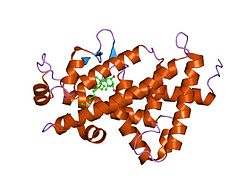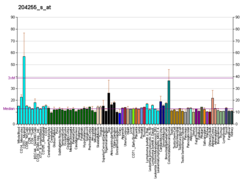The vitamin D receptor (VDR also known as the calcitriol receptor) is a member of the nuclear receptor family of transcription factors.[5] Calcitriol (the active form of vitamin D, 1,25-(OH)2vitamin D3) binds to VDR, which then forms a heterodimer with the retinoid-X receptor. The VDR heterodimer then enters the nucleus and binds to Vitamin D responsive elements (VDRE) in genomic DNA. VDR binding results in expression or transrepression of many specific gene products. VDR is also involved in microRNA-directed post transcriptional mechanisms.[6] In humans, the vitamin D receptor is encoded by the VDR gene located on chromosome 12q13.11.[7]
VDR is expressed in most tissues of the body, and regulates transcription of genes involved in intestinal and renal transport of calcium and other minerals.[8] Glucocorticoids decrease VDR expression.[8] Many types of immune cells also express VDR.[9]
- ^ a b c GRCh38: Ensembl release 89: ENSG00000111424 – Ensembl, May 2017
- ^ a b c GRCm38: Ensembl release 89: ENSMUSG00000022479 – Ensembl, May 2017
- ^ "Human PubMed Reference:". National Center for Biotechnology Information, U.S. National Library of Medicine.
- ^ "Mouse PubMed Reference:". National Center for Biotechnology Information, U.S. National Library of Medicine.
- ^ Moore DD, Kato S, Xie W, Mangelsdorf DJ, Schmidt DR, Xiao R, Kliewer SA (December 2006). "International Union of Pharmacology. LXII. The NR1H and NR1I receptors: constitutive androstane receptor, pregnene X receptor, farnesoid X receptor alpha, farnesoid X receptor beta, liver X receptor alpha, liver X receptor beta, and vitamin D receptor". Pharmacol. Rev. 58 (4): 742–59. doi:10.1124/pr.58.4.6. PMID 17132852. S2CID 85996383.
- ^ Lisse TS, Chun RF, Rieger S, Adams JS, Hewison M (June 2013). "Vitamin D activation of functionally distinct regulatory miRNAs in primary human osteoblasts". J Bone Miner Res. 28 (6): 1478–14788. doi:10.1002/jbmr.1882. PMC 3663893. PMID 23362149.
- ^ Szpirer J, Szpirer C, Riviere M, Levan G, Marynen P, Cassiman JJ, Wiese R, DeLuca HF (September 1991). "The Sp1 transcription factor gene (SP1) and the 1,25-dihydroxyvitamin D3 receptor gene (VDR) are colocalized on human chromosome arm 12q and rat chromosome 7". Genomics. 11 (1): 168–73. doi:10.1016/0888-7543(91)90114-T. PMID 1662663.
- ^ a b Fleet JC, Schoch RD (August 2010). "Molecular Mechanisms for Regulation of Intestinal Calcium Absorption by Vitamin D and Other Factors". Crit Rev Clin Lab Sci. 47 (4): 181–195. doi:10.3109/10408363.2010.536429. PMC 3235806. PMID 21182397.
- ^ Adorini L, Daniel KC, Penna G (2006). "Vitamin D receptor agonists, cancer and the immune system: an intricate relationship". Curr Top Med Chem. 6 (12): 1297–301. doi:10.2174/156802606777864890. PMID 16848743.







